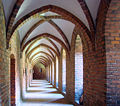Carmelite Priory, Helsingør

The Carmelite Priory, Helsingør, or Priory of Our Lady, Helsingør (Vor Frue Kloster), was a house of
History
Carmelites
The Priory of Our Lady was established in 1430 for a group of Carmelite friars from
The Carmelites were a mendicant order (tiggermunk) which means that at least in the beginning they depended on the generosity of local residents for their sustenance. They were sometimes called the "little white friars". King Erik invited them into Denmark and established the priory of Our Lady in Helsingør to ensure that they remained. As time passed the priory received many properties scattered all over Zealand which decreased their dependence on others. The priory in Helsingør eventually became the headquarters for the Carmelites in Scandinavia.
Its property was a gift from King Erik, and included several farms for its maintenance. The buildings were of red brick, the most common building material of the day in the region. The three main buildings were built around a central garden and cloister, with the church of St. Mary forming the fourth side to the south. The church was built as a three-aisled basilica, but the central nave was built significantly higher than the others in the Gothic style.
The oldest buildings were destroyed by a fire in 1450, resulting in its current appearance which dates to 1500, when the building of the church was completed. In 1516 a hospital was created here for foreign sailors.
The most influential Carmelite from the priory in Helsingør was
Dissolution and after
After the dissolution of the priory in 1536 during the
From 1930 a small number of single women lived in the buildings as an almshouse, the last of whom left in 1986. In 1989 the local church and episcopal authorities took over the buildings and still occupy part of them. In 1992 restoration work was carried out on the frescoes in the former conventual buildings.
- Priory
-
Conventual range
-
Cloister
-
Cloister garth
St. Mary's Church
The first intention after the dissolution of the priory was to demolish the church, but it found use as a warehouse and as stabling for horses, which preserved it until 1577, when it was made available to the foreign community residing in Helsingør, mostly Germans from the cities of the
Between 1900 and 1907 the church and the conventual buildings were entirely restored under Professor
St. Mary's is home to a magnificent
- Church
-
Interior
-
Frescoes
-
Nave
-
Pulpit
-
Organ
Sources
- Helsingørdomkirke.dk: Sanct Olai Kirke and Sanct Mariæ Kloster[permanent dead link] (in Danish)
- Helsingorleksikon.dk: Sct. Mariae Kirke (in Danish)
References
- Henningsen, Henning, 1995: Sct. Mariæ Kirke og Vor Frue Kloster i Helsingør. Sct. Mariæ Sogns Menighedsråd (in Danish)








